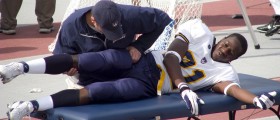
Whatis the Ankle Ligament?
Theankle is bound by tendons and ligaments, and attaches to the foot bythese ligaments on either side of the ankle. On the inside of theankle is a complicated web of ligaments that are stronger than theone on the outside of the ankle, where there are only two ligaments.This is in order to limit the movement of the ankle itself. The bones ofthe foot are attached, via the ankle to the muscles in the leg by thesetendons. The ankle mainly moves in a single plane or direction: upand down, and normally does not tilt or move front to back. Injuringthese ligaments can tear or stretch them, causing a sprain andreducing their strength. If the injury is severe enough, cartilagearound the ankle can be damaged or the rotation of the ankle can alsocause the bones to break or fracture, causing severe pain andrestriction of function. This usually requires a surgical procedure.
Causesof Ankle Ligament Tears
Anankle sprain can sometimes occur during walking, running or fallingfrom heights, the most common of which is the inversion sprain. Awrong step can cause the ankle and outside of the foot to roll overtowards the ground, causing the ligaments on the outside of the ankleto pull very hard, damaging or tearing them. Several types of damagecan occur, including stretching, tearing either partially or fully,dislodging the ligament's connection to the bone and also perhapspulling a piece of bone along with it. Any number of the ligamentscan potentially be damaged, depending on the amount of rotation ofthe foot and how severe the injury is. Multiple sprains during ashort period can lead to the ligaments becoming weaker, thus causingthe ankle to become unsteady.
Symptomsof Ankle Ligament Tears
Swelling,bruising, discolouration and naturally pain are all symptoms of anklesprains and ligament damage. Usage of the sprained ankle can beseverely limited, depending on the extent of the damage, and theankle may also feel like it is locking or clicking when moved. Painis usually felt around the bone on the exterior of the ankle, as wellas the tendons, ligaments and lateral aspects of the ankle.
Diagnosis
Adoctor will run certain tests, such as gentle movement of the jointto determine the severity of the damage, muscle testing, x-rays of the jointand even stress x-rays to determine how much the ankle hasdislocated. Rarely, an MRI scan may be necessary for a completepicture of the extent of the damage.
Treatmentof the Injury
Restis the most important factor in recuperation. Ice andanti-inflammatory medicines can also be applied to the affected areato relieve pain and swelling. The ankle may require a cast or boot toset the joint correctly to allow for proper healing, which may takeseveral months. Surgery may also be necessary to correct ligamentpositions or fix breakages of tendons or bones.
Ankleinstability will remain for quite a while even after the ankleligaments have fully healed. Strenuous activity using the ankle mustbe avoided for some time after the recovery in order to not unduly stressthe ligaments as they return to full strength.

















Your thoughts on this
Loading...